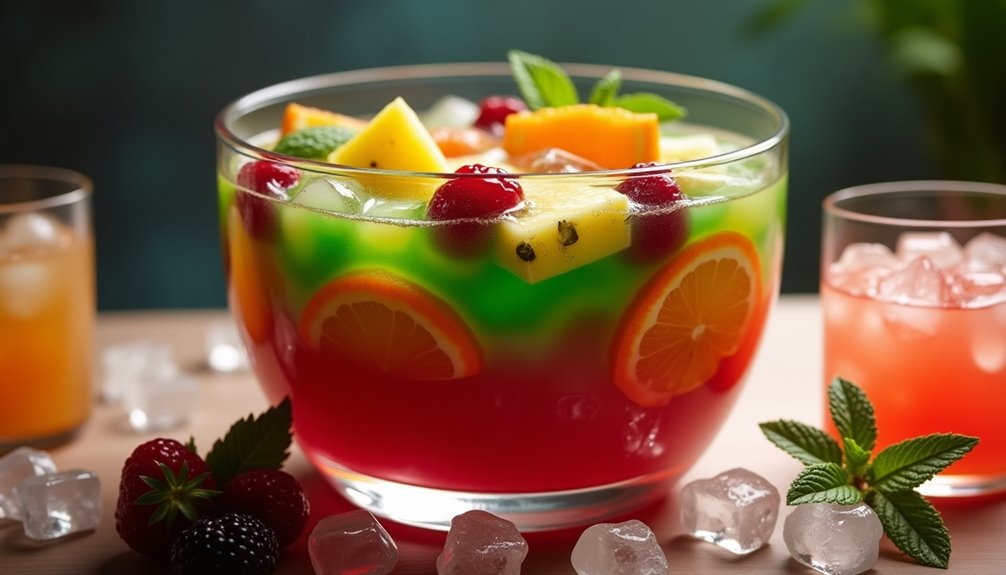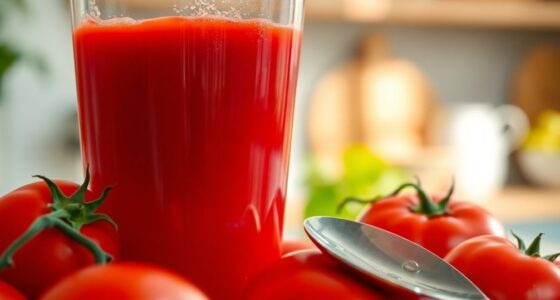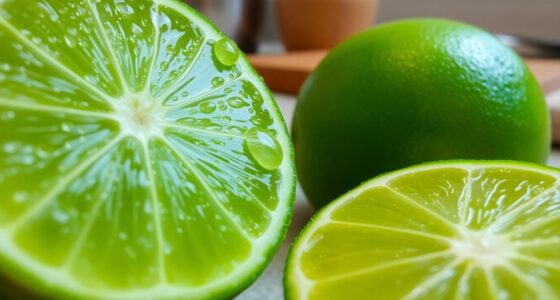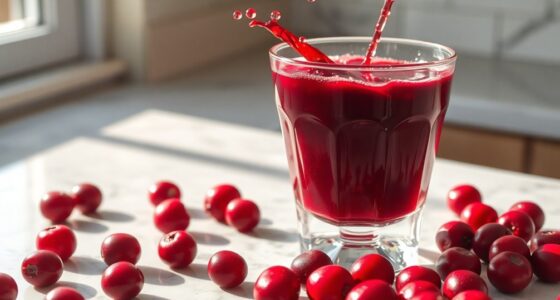To make jungle juice, start by pouring equal parts of lemonade, orange juice, and cranberry juice into a large punch bowl. Add a 750-milliliter bottle each of vodka and rum, along with fresh fruit like sliced oranges and strawberries. Chill the mixture for a few hours before serving over ice. You can adjust the flavor by adding simple syrup for sweetness or even some fizzy tonic water. Keep going to explore more tips for a perfect blend! For an extra twist, consider incorporating herbs like mint or basil to elevate the flavor profile. If you’re interested in other culinary delights, don’t hesitate to explore how to make cottage cheese, which can be a nutritious addition to your snacks and meals. Remember, presentation matters, so serve your jungle juice in colorful glasses for a fun and festive look!
Key Takeaways
- Combine equal parts lemonade, orange juice, and cranberry juice in a large punch bowl or beverage dispenser.
- Add a 750-milliliter bottle each of vodka and rum to the juice mixture.
- Slice fresh fruit, such as oranges and strawberries, and incorporate them into the punch.
- Chill the mixture in the refrigerator for several hours to enhance the flavors.
- Serve over ice, adjusting sweetness or strength as needed for personal taste.

If you're looking to whip up a fun and refreshing party drink, jungle juice is a fantastic choice. This vibrant, fruity concoction is perfect for gatherings, and it's an easy jungle juice recipe that'll impress your friends. You don't need to be a mixologist to create this delicious fruit punch; with just a few ingredients, you can mix the alcohol and fresh fruit for a drink that's sure to be a hit.
To start, you'll need a full 750-milliliter bottle each of vodka and rum. These two spirits form the backbone of your jungle juice, providing that kick everyone loves. Once you've got your alcohol, grab a large punch bowl or a beverage dispenser to hold all your ingredients. The size is essential because a jungle juice recipe is meant to serve a crowd.
Next, you’ll want to add your fruit juices. A combination of lemonade, orange juice, and cranberry juice works wonders together. Pour equal parts of each juice into the bowl, ensuring you have a nice balance of sweetness and tartness. This mix not only enhances the flavor but also creates a beautiful, colorful base for your drink. To elevate the flavor profile even further, consider adding some freshly grated ginger to the mix. If you’re curious about how to juice fresh ginger, simply peel the root and use a juicer or a grater to extract the juice, which brings a zesty kick and adds depth to your drink. Stir well to incorporate all the ingredients, and don’t forget to taste and adjust the sweetness or tartness to your preference.
Now it's time to add the fresh fruit. Slice up some oranges and strawberries, and toss them into the mixture. Pomegranate seeds are also a lovely addition, adding a pop of color and a burst of flavor. The fresh fruit isn't just for decoration; it infuses the punch with additional flavor as it sits. Let the mixture chill in the refrigerator for several hours to allow the flavors to meld.
After it's chilled, taste your jungle juice. This is where you can make adjustments. If you find it too strong, you can dilute it with a bit of water or add simple syrup to sweeten it up. The goal is to get the perfect balance that suits your taste, so don't hesitate to tweak it until you've got just the right mix!
When it's time to serve, pour the jungle juice over ice in cups or glasses. For an extra fizzy twist, consider adding tonic water or prosecco just before serving. This will give your drink a delightful sparkle that everyone will love.
As you serve your jungle juice, watch as your friends dive into this delicious fruit punch. The combination of vodka and rum, mixed with the refreshing juices and fresh fruit, creates a delightful beverage that captures the essence of a good time. It's the best jungle juice recipe you'll ever make, bringing together the perfect blend of flavors and fun.
Frequently Asked Questions
What Is Jungle Juice Made Of?
Jungle juice typically combines various fruit juices, like lemonade, orange juice, and cranberry juice, which mask the taste of alcohol.
You'll often find vodka and rum as the main spirits, creating a strong punch.
Fresh fruits, such as sliced oranges, strawberries, and pomegranate seeds, add flavor and a burst of color.
What's great is you can customize the ingredients based on your preferences, making it a versatile choice for parties and gatherings.
What Are the Components of Jungle Juice?
When you're thinking about the components of jungle juice, you'll want to start with a mix of fruit juices like lemonade, orange juice, and cranberry juice.
Then, choose your alcohol—vodka and rum are popular choices, but you can experiment with others.
Fresh fruits like oranges and strawberries add flavor and color.
Lastly, feel free to customize with flavored lemonades or different juices to match your taste preferences!
What Are the Ingredients in Jungle Juice Cocktail?
When you're looking to whip up a jungle juice cocktail, you'll need a mix of vodka and rum as your base spirits.
Then, grab some fruity juices like lemonade, orange juice, and cranberry juice to balance the flavors and mask the alcohol.
Don't forget to add fresh fruits like sliced oranges, strawberries, and pomegranate arils for garnish.
Feel free to customize the ingredients based on your taste preferences for a unique twist!
How to Make Jungle Juice With Kool-Aid?
To make jungle juice with Kool-Aid, start by mixing one or two packets of your preferred Kool-Aid flavor in about 2 quarts of water.
Then, combine the Kool-Aid with equal parts of fruit juices like orange juice and lemonade.
Pour in a 750-milliliter bottle of vodka and rum, adjusting as needed.
Finally, toss in fresh fruit slices for extra flavor and let it chill in the fridge for a few hours before serving.
Conclusion
Now that you know how to make jungle juice, you can impress your friends at the next gathering! Just remember to mix responsibly, as studies show that about 40% of college students have tried it at least once. It's a fun, fruity drink that can bring everyone together, but moderation is key to ensure everyone has a great time. So grab your ingredients, get creative, and enjoy your homemade jungle juice safely! Cheers!
Cindy thoroughly researches juicing trends, techniques, and recipes to provide readers with practical advice and inspiration. Her writing style is accessible, engaging, and designed to make complex concepts easy to understand. Cindy’s dedication to promoting the advantages of juicing shines through her work, empowering readers to make positive changes in their lives through the simple act of juicing.

















